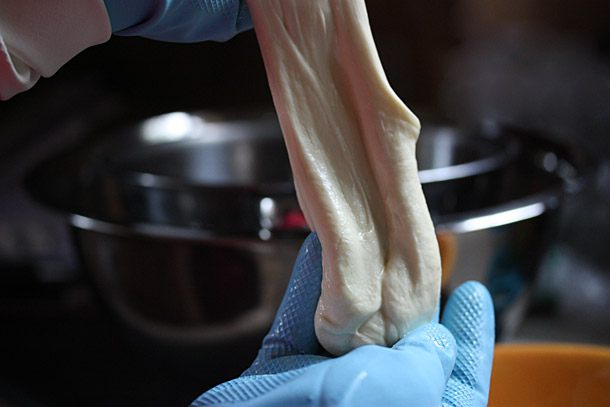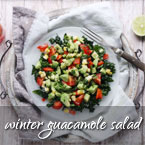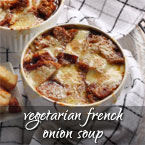Fresh Mozzarella & Local Milk
It was summer, and I had loads of cherry tomatoes and basil on the counter. I wanted mozzarella. I needed mozzarella. And my cheesemaking book said it’s the easiest to make. I even had vegetable rennet on hand. Score.
The results were … [drumroll] … disappointing.
But not for the reasons you might expect. I made no technical errors, no measuring errors. No temperature errors.
No, this project was ruined by the U.S. food distribution chain and its food handling requirements.
But that was years ago. Thanks to the local movement, homemade cheese is finally within my reach.
It All Starts with Milk
Grocery store milk suffers the same failings as most of the other items dominating the shelves of modern supermarkets: it’s over-processed.
To survive the long journey from far away dairies, milk is heated briefly to a very high temperature — 275°, far above boiling — destroying as much microbial life as possible in a process known as UHT (or ultra-high temperature) pasteurization. This produces a milk product with a considerable shelf-life, up to 60 days.
It also produces a relatively flavorless milk, absent of beneficial microbes and enzymes. I call this ghost milk, milk that is a shadow of its former self.
Next time you’re at the grocery store, check the label of the milk product you’re purchasing. If it says “ultra-pasteurized,” you’re getting ghost milk/half and half/cream.
So, what does this have to do with my initial failed mozzarella cheese experiment?
Ultra-pasteurized milk is deficient in the enzymes required to produce a good, smooth-curdy cheese. I searched high and low for un-ultra-pasteurized milk (having been warned by the mozzarella recipe-writer) and met with utter failure. I bought a gallon anyway, and my first mozzarella test yielded a disturbingly stringy, grainy puddle that tasted like … nothing. So did the second test. And the third.
I gave up.

Skip ahead to today, and thanks to social media and the locavore movement, small dairies can make themselves known and attract a new customer base that was previously beyond the reach of their advertising budget. Through Facebook, I discovered an Ohio dairy that sells milk at stores mere miles from my house. Sensibly (read, not ultra), legally pasteurized and delightfully unhomogenized (you have to shake the carton). Real milk. I hadn’t drank a plain glass of milk in 20 years. I was hooked.
Enter Warren Taylor (above), CEO of Snowville Creamery in Pomeroy, Ohio. I took this photo at my area Whole Foods store. If I hadn’t already become smitten with Snowville through contact on Facebook, this sealed the deal. This is what I want to see from the people who produce the food I consume: responsibility — that’s the CEO’s own face fronting his product — and transparency. (I don’t ever recall seeing Jack DeCoster promoting the eggs he produced.)
One more thing before I get to the cheese: my favorite Snowville story. Earlier this Spring, a friend of mine noted that the color of her new Snowville milk was buttery yellow instead of creamy white. A quick question to and response from Taylor revealed that the cows had been grazing on dandelions in the fields. How awesome is that?

So, let’s try this experiment again, this time with Snowville milk. Vegetable rennet (on the right, above) will help move things along to their creamy end.

Ah! There they are! Curds, firm enough to slice with a knife. This critical step just never happened with ultra-pasteurized product.

This is my favorite part — stretching and kneading the cheese. So achingly smooth and creamy. If it weren’t for the fact that the strand was 135° at this point (hence the gloves), I would’ve bitten off a chunk right then and there.

Oops! I was so excited to try the result that I forgot to photograph it before digging in. This is the smaller [ahem, much smaller], reshaped remains from my mozzarella feast. Delicious!
Havarti, you’re next, my friend.
For a step-by-step photo tutorial of the super-easy recipe I followed, visit Cheesemaking.com. While you’re there, browse the other recipes that Ricki includes on her site.

Comments:
Comments are closed.












I can’t tell you how excited I am to find out about Snowville Dairy and that I can get these products at Jungle Jim’s! Thanks!
Woo hoo! (And on a side note, I’m excited that Jungle Jim’s is coming to my side of town. I cannot wait….)
SoupA … sorry, L&G, you have shot up even further in my appreciation of your many and varied talents. Homemade cheese? Wow, just wow. Is it really worth the effort in terms of better-tasting mozzarella? If you say so, I believe you.
Aw, that’s really sweet to say, but making mozzarella is so easy, I’m really not worthy of that praise.
Making your own butter is worth it, hands down, especially if you’re going to make compound butter (i.e., add things to it, like herbs).
Cheese-making is a different kind of project for me, almost more philosophical than anything. Over the last few years, it’s struck me — hard — how removed we are from knowing how our food is produced. We go to the grocery store and add things to our carts, in exactly the same way we add aspirin and paper towels and shoestrings. In fact, most of us can buy these items — food and incidentals — in the same store. When I think about it too long (and I do, often), it seems wrong, obscene. (I’m not denying the convenience of it, believe me — again, this is more philosophical than anything.)
So, it’s been an ongoing experiment for me, making these things at home from scratch, although I haven’t written much about it either here or on soupaddict.com. I’ll see something in grocery store and ask myself, “just what is this, and can I make it at home? Would my grandmother have wanted to make this?”
This weekend, I made ginger ale floats completely from scratch (ice cream, ginger syrup, seltzer the whole shebang). They were delicious! I won’t do it every weekend, but, now I know how they’re made.
To answer your question (at last ): as for the mozzarella, the cheese is only going to be as good as the milk. If you can’t find really good, minimally pasteurized milk, don’t bother – it’s a waste of money. But the great thing about cheese, in particular, is that there are passionate artisans out there who care about what they’re doing and do it right, reasonably priced, so I feel quite comfortable and at peace with purchasing cheese from even non-local sources like Cabot Creamery.
): as for the mozzarella, the cheese is only going to be as good as the milk. If you can’t find really good, minimally pasteurized milk, don’t bother – it’s a waste of money. But the great thing about cheese, in particular, is that there are passionate artisans out there who care about what they’re doing and do it right, reasonably priced, so I feel quite comfortable and at peace with purchasing cheese from even non-local sources like Cabot Creamery.
But, it’s a fun project, and worth trying (with the above caveat). High on my list: homemade ricotta. Tubbed grocery store ricotta has a texture issue that irks me. I want to conquer that.
That was such a great response, thanks.
I can get the right milk and can probably find rennet and citric acid. But you’ve intrigued me (oooh, look, shiny!) with the idea of making my own butter first. I shall start small and work my way up because I, too, want to know how things are made and what goes into them.
I tried making mozzarella myself using calf rennett – which is what I could find at my local store. Do you know if there is a difference in the final product when using the animal rennet versus vegetable rennet? I will try again as I didn’t like the texture so much of the one I made. It was a little rubbery. We have a pizza oven in our backyard and I thought it would be nice to make my own cheese since it can get expensive purchasing the good balls of mozzarella.
I don’t think there’s much of a difference for young cheeses like mozzarella (aged cheeses do better with calf rennet, in fact).
Here’s a fantastic resource for troubleshooting mozzarella and for cheese-making in general (in fact, I purchase my supplies from her):
http://www.cheesemaking.com/store/pg/242-FAQ-Mozzarella.html
Don’t lose heart – I think you’re looking at only small adjustments to your technique, and you’ll have it down!
(Also, cheers for the backyard pizza oven! I’ve been tempted to make a beehive oven for years….)
Nice! I just got one of my sons a mozzarella and ricotta-making kit for Christmas, he’s excited to try it when he’s back in his own kitchen. I’ll forward him this link, I know of a dairy near where he lives that has really good milk (Pure Eire). Here in the Seattle area our family has been pretty spoiled for local milk. For years we had home delivery from Smith Brothers Farm, they are one of the few owner=producer-handlers left around and their milk, from only their cows, was on my doorstep fresh 24-48 hours from when it was milked. Now I don’t use milk when the children are not home so no more delivery, but still a soft spot for the farm.
Ditto. I don’t actually consume much dairy anymore – although one of Snowville’s new projects is yogurt (and, I’m hoping, kefir), which makes me extremely happy. They’re currently testing it in stores near them before they start distributing it along they’re regular routes. Patience, Karen, patience.